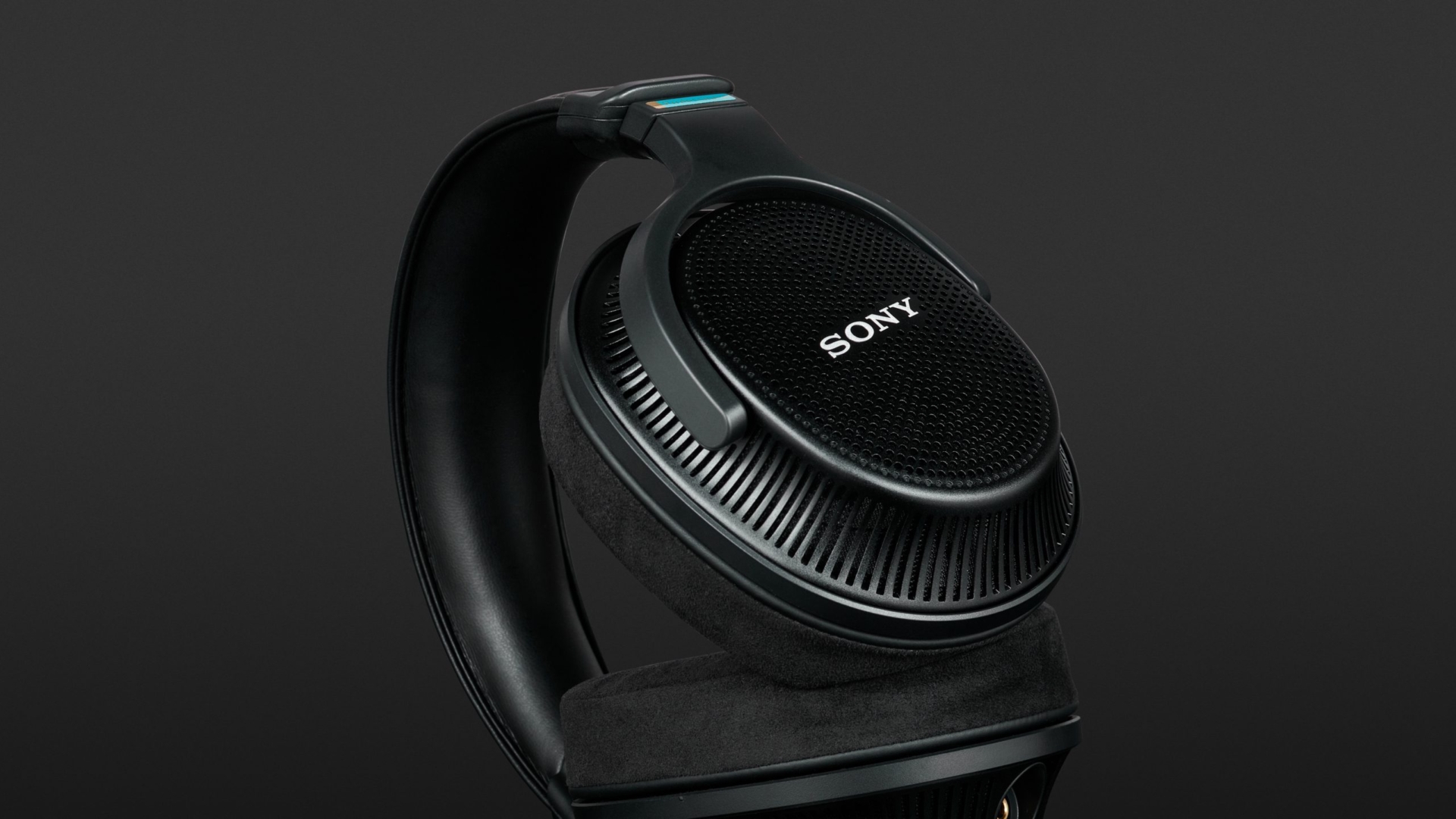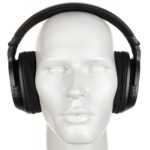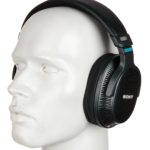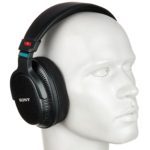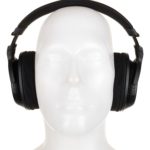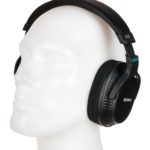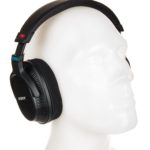If you are looking for mixing and mastering headphones that offer a neutral, uncoloured sound as well as a certain warmth – but that do not sound analytically “cold” – you should definitely have the Sony MDR-MV1 on your radar.
In fact, the spectrum ranges from resonance-free ultra-deep sub-basses to unflustered, detailed mids and open but discreet upper frequencies. This sound, coupled with high wearing comfort and smooth handling, undoubtedly make these open headphones suitable for professional music reproduction.
However, it would be helpful if the manufacturer could simplify the initial use of the app so that the creation of a headphone listening profile for 3D Audio was faster.
- resonance-free low frequencies
- finely detailed mids
- excellent speech intelligibility
- open sound
- great wearing comfort
- smooth handling
- slightly muffled sound in the treble range
- comparatively small contents of delivery
- time-consuming initial setup of the app connection
The Sony MDR-MV1 are circumaural open studio headphones with dynamic operation and an extremely wide frequency range. Their HD drivers have been newly developed by Sony and are also suitable for the reproduction of 3D audio.
The Sony MDR-MV1 are most likely to convince users who are looking for a neutral, uncoloured sound that nevertheless retains a certain warmth and does not sound analytically “cold”. However, there is still room for the manufacturer to simplify the initial set-up of the app so that creating a headphone listening profile for 3D audio is quicker.

The Sony MDR-MV1 are open studio headphones for mixing and mastering in professional music reproduction. In our practical review, we put these high demands to the test.
Sony MDR-MV1 package
In addition to the headphones themselves, the Sony MDR-MV1 package includes a 2.50m interchangeable cable and a short adapter cable with a 3.5mm jack plug. In addition, two multilingual user manuals are included. That’s about it. Unlike other headphones in this price range, there is neither a case nor a carrying bag on offer. The package is therefore not extensive, but it provides everything needed for immediate use.
Sony MDR-MV1 – design and construction
The Sony MDR-MV1 have a sleek appearance. These headphones are all black, and the components are mostly made of plastic. Alongside shiny silver Sony logos, two metal stickers on the ends of the headband are designed to catch the eye, with the word “Professional” underlining the manufacturer’s claim that we are dealing with a device for serious work.
It is noticeable that the ear cups not only have perforated backs but also have slots all around. These headphones, therefore, are deservedly described as an “open design”. The ear pads on the ergonomically positioned ear cups can be replaced.
Although neither a case nor a pouch is included with these headphones, the ear cups can be rotated into a flat position to save space for storage and transport. The connection for the interchangeable cable is made via a 3.5mm mini jack with screw fixing. The other enclosed cable ends with a 6.35mm jack plug typical for use with hi-fi equipment. In order to be able to use the headphones on an output with a 3.5mm jack socket, the enclosed adapter can be used.
The overall design is unspectacular and, compared to some competing models, is decidedly understated.
Technology and values of the Sony MDR-MV1
The Sony MDR-MV1’s 40mm drivers are dynamically driven by powerful neodymium magnets. They reproduce audio in the frequency range from a super-low 5 Hz up to an incredibly high 80 kHz. This means that their reproduction range exceeds human hearing many times over. The sensitivity of the MDR-MV1 is not too high at 100 dB SPL. However, we are dealing with open studio headphones for mixing and mastering and not with closed DJ headphones. Therefore, in practice, this should be fine. With an impedance of 24 ohms, these headphones are also suitable for low-voltage outputs. This means that the MDR-MV1 can also be used directly with audio interfaces. Even though the low impedance allows them to be used with smartphones etc., this is likely to be rather impractical for everyday use due to the long cable.
The handling of the Sony MDR-MV1
Connecting the interchangeable cable requires no effort. It is plugged in and secured with a screw head to prevent it from accidentally slipping out. When I put on the Sony MDR-MV1 with the smallest headband setting, they automatically adjusted to the size of my head. The headband setting was maintained even after the headphones were taken off because of the ratcheted size adjustment. The headband also features measurement numbers so that the desired size can be reproduced at any time without having to put the headphones on. The rotating and swivelling ear cups mean that the Sony MDR-MV1 adapts well to the shape of your head. The ear pads, with their breathable velour cover and memory foam, ensure a particularly comfortable fit.
Because the device weighs only 223g without the cable, the contact pressure of these headphones does feel particularly high. It is just strong enough so that the device does not slip significantly during rapid head movements. Even wearing the headphones for a long time in mixing sessions lasting several hours was not a problem. The included 2.5m straight cable provided a lot of freedom of movement. If you use the adapter to a 3.5mm jack plug, which is also included in the package, the range is extended by about 22.5cm.
Sony MDR-MV1 – Sound
As is to be expected with open headphones, the bass components of the Sony MDR-MV1 are underrepresented in the reproduction. However, when they were boosted, the MDR-MV1 reproduced them effortlessly. This was also true at higher volumes. Due to the very open design, these headphones reproduced deep basses in their pure form because there were no disturbing resonances. The sound of these headphones was, therefore, as precise and defined in the basses as had been promised.
In the mid-range, these headphones provided a wonderfully fine resolution. It is possible to hear previously undiscovered nuances in vocals, keyboards and guitars. The speech intelligibility delivered by these headphones was excellent, even in crowded mixes.
The MDR-MV1’s highs came across as clear without being demanding, as advertised by the manufacturer. The super high-frequency range, which extends to 80 kHz, provided an open sound experience that neither glossed over nor sounded harsh. This balance applied to the entire audio spectrum. However, for me, the sound image seemed very slightly muffled in the highs. Therefore, to suit my own personal taste, a manual boost of the treble was necessary. The MDR-MV1 handled this effortlessly.
Overall, the sound was pleasant, and despite the richness of detail, it was not analytically “cold”, yet it did not colour the tone. The reproduction was low in distortion, even up to high volumes. However, even though the transient imaging of these headphones was precise, to me, the overall sound did not seem as dynamic as with some competing devices.
The stereo impression of these headphones was well positioned due to the quite high subjective signal resolution and ensured a differentiated location of the phantom sound source. The MDR-MV1’s depth gradation was also appealing simply because of the openness of their sound.
The acoustic isolation from the outside was almost zero with these headphones. Of course, in this case, that is a sign of quality. Accordingly, the attenuation of external noise was also low.
3D audio with the Sony MDR-MV1
In the “Headphones” app provided by Sony, the Sony MDR-MV1 can be registered, and a photo analysis of your ears can be carried out. On the basis of this data, the app then calculates a sound profile that is intended to optimise the headphones’ playback. However, this optimisation can only be used in conjunction with certain playback apps. This includes the “360 Reality Audio Live” app offered by Sony. However smooth the operation of these headphones is and however well explained (though unfortunately with quite a few steps) the calculation of the listening profiles is, the initial use of the app, which is compatible with 3D Audio, is awkward. Unfortunately, there is no quick registration via a Google account or similar. Instead, you must fill in and click the link in a confirmation email. In addition, a code from the manufacturer is required for full use of the app.
All in all, the use of 3D Audio, with its multiple registrations and different apps, was too cumbersome for me. And for all the effort expended on the part of the user, the sound that resulted after adapting the app to your own ears doesn’t exactly knock your socks off. In addition, I personally found it cumbersome to use an app on a smartphone or tablet for studio operation. Therefore, I would say that the option of using the app was more of a gimmick than a professional tool.
Technical specifications
- Ear couplingOver-ear
- Typeopen
- Transducer principledynamic
- Frequency response (headphones)5 - 80.000 Hz
- Impedance24 ohms
- Sound pressure level (SPL)100 dB dB
- Weight without cable223 g
- Cable length250 cm
What's in the box
- 2,50 m long interchangeable cable
- adapter cable to 3.5 mm jack plug











